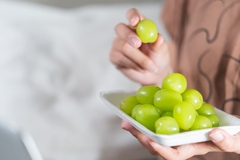Personalized treatments for diabetes prevention point to carb metabolism
A new study reveals that one’s metabolic health determines how blood sugar responds to certain carbohydrates. Researchers at Stanford Medicine, US, suggest creating personalized prevention treatment strategies for prediabetes and diabetes based on a patient’s blood sugar response patterns.
The study published in Nature Medicine involved 55 participants who had no history of type 2 diabetes and who underwent metabolic testing. Metabolic health conditions include insulin resistance and beta cell dysfunction, which can lead to diabetes. Beta cells produce the hormone insulin in the pancreas, which helps convert glucose in the blood to energy.
Researchers found that many experienced a blood glucose spike after eating rice or grapes, regardless of their metabolic health status. High blood sugar levels, or hyperglycemia, are used to diagnose diabetes.
“Right now, the American Diabetes Association dietary guidelines do not work that well because they lump everyone together. This study suggests that not only are there subtypes within prediabetes, but also that your subtype could determine the foods you should and should not eat,” says Michael Snyder, Ph.D., professor in Genetics at the university.
Pasta or potatoes?
The study participants ate same-sized portions of various carbs while continuously wearing glucose monitors. They consumed jasmine rice, buttermilk bread, shredded potatoes, pasta, canned black beans, grapes, and a berry mix containing blackberries, strawberries, and blueberries.

Twenty-six participants were found to have prediabetes. However, researchers were not surprised since one in three people in the US has prediabetes.
Blood glucose response to resistant starch in foods, like potatoes and pasta, varied depending on their metabolic dysfunction. “Starchy foods were not equal; there was a lot of individual variability in which foods produced the highest glucose spike,” says study co-author Yue Wu, Ph.D., postdoctoral scholar in genetics.
Pasta caused the highest blood sugar spikes in those who had insulin resistance, while potato had the same effect on those with insulin resistance or beta cell dysfunction.
Participants sensitive to potatoes also had high triglycerides, fatty acids, and other metabolite levels seen in people with insulin resistance.
The researchers suggest that comparing blood glucose responses to potatoes versus grapes is linked to insulin resistance. They believe this ratio could serve as a real-world biomarker for insulin resistance in the future.
“Such a biomarker would be useful because insulin resistance is amenable to lifestyle and medication interventions that can reduce risk for diabetes in high-risk individuals. At present there is no easy way to diagnose it in the clinic,” says study co-lead Tracey McLaughlin, MD, professor of endocrinology.
The study found that eating fiber or protein before the rice lowered the glucose spike, and eating fat before the rice slowed the spike peak.Researchers also found that blood sugar spikes associated with beans were caused by histidine and keto metabolism, in which the body uses fat for energy.
They suggest spikes tied to eating bread may lead to hypertension, or high blood pressure.
Eat carbs last
The study also found that eating fiber or protein before the rice lowered the glucose spike, and eating fat before the rice slowed the spike peak.
However, this was only observed in those metabolically healthy who were insulin sensitive or had normal beta cell function. Those with insulin resistance or beta cell dysfunction did not experience the same effect.
“Eating carbohydrates later in a meal is still a good idea even though it has not yet been sorted out whether it is best to eat protein, fat, or fiber before carbohydrates. Eat your salad or hamburger before your French fries,” Snyder comments.
Study controls
The participants ate pea fiber powder, protein from boiled egg whites, or crème fraîche (fat) ten minutes before eating rice.
They also ate in the morning after a 10–12 hour fast and consumed each food type twice. Blood sugar was monitored up to three hours after meals.
Researchers tested for insulin resistance, beta cell dysfunction, and multi-omics profiling, which included tests for triglyceride levels, metabolites in blood plasma, liver function, and gut microbiome.
In other news, research has found that the type of sugar and its source matter more when at risk of diabetes than previously thought. Drinking sugar was found to increase the risk of the chronic condition, while eating it showed a possible protective association.












